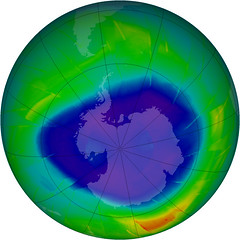Photo of ozone hole over Antarctica: NASA Goddard
It’s rare these days to find some really big, good environmental news. There are lots of promising little schemes, such as the reintroduction of red kites, and the creation of large coastal nature reserves in the UK. But advances on a genuinely global scale — well, we thought that sort of thing was some way off.
So the news that the ozone layer is no longer depleting and could recoup its strength by 2048, according to a United Nations report, could well be something to celebrate, particularly as it is the result of speedy international action.
Older readers will recall that the hole in the ozone layer, somewhere over Antarctica, was the dominant environmental issue of the mid to late 1980s, well before global warming began to dominate the agenda. There was a lot of gloomy talk. The public certainly woke up to the issue, probably because the consequences — a possible rise in skin cancer — were direct and easily understood , while the solution (although then I think we were talking about slowing the loss rather than reversing it) could be easily grasped as well. For a start, change the way we chilled refrigerators. and what was so difficult about that?
What the update by the joint World Meteorological Organization and U.N. Environment Program (the first in four years) is saying is that international efforts to protect the ozone layer, which protects life on Earth from harmful levels of ultraviolet rays, are a success and have stopped additional ozone losses.
The principal cause of the shield’s thinning at the end of the 20th century was ozone depleting chemicals, such as CFCs (chlorofluorocarbons) found in refrigerants and aerosol sprays. A thinning ozone layer threatened damage to human immune systems, wildlife and agricultureThe international community move relatively swiftly, and signed the Montreal Protocol on Substances that Deplete the Ozone Layer. It went into effect in 1989, calling for the phasing out of production and consumption of ozone-depleting substances. Now the World Meteorological Organization Research Department says the treaty is working.
The department says it has protected us from severe ozone depletion over the past decade. The layer is no longer decreasing, but not yet increasing.
The ozone layer is projected to return to 1980 levels by the middle of this century, which is somewhat earlier than foreseen in the last assessment, in 2006.
The report says the Montreal Protocol has had direct benefits for public health. Without the treaty, ozone depleting substances were projected to increase ten-fold by 2050. This could have led to up to 20 million more cases of skin cancer and 130 million more cases of cataracts.

